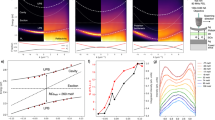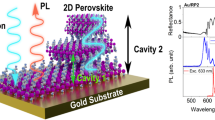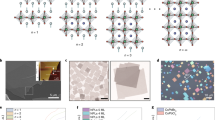Abstract
Exciton polaritons, the part-light and part-matter quasiparticles in semiconductor optical cavities, are promising for exploring Bose–Einstein condensation, non-equilibrium many-body physics and analogue simulation at elevated temperatures. However, a room-temperature polaritonic platform on par with the GaAs quantum wells grown by molecular beam epitaxy at low temperatures remains elusive. The operation of such a platform calls for long-lifetime, strongly interacting excitons in a stringent material system with large yet nanoscale-thin geometry and homogeneous properties. Here, we address this challenge by adopting a method based on the solution synthesis of excitonic halide perovskites grown under nanoconfinement. Such nanoconfinement growth facilitates the synthesis of smooth and homogeneous single-crystalline large crystals enabling the demonstration of XY Hamiltonian lattices with sizes up to 10 × 10. With this demonstration, we further establish perovskites as a promising platform for room temperature polaritonic physics and pave the way for the realization of robust mode-disorder-free polaritonic devices at room temperature.
This is a preview of subscription content, access via your institution
Access options
Access Nature and 54 other Nature Portfolio journals
Get Nature+, our best-value online-access subscription
$29.99 / 30 days
cancel any time
Subscribe to this journal
Receive 12 print issues and online access
$259.00 per year
only $21.58 per issue
Buy this article
- Purchase on Springer Link
- Instant access to full article PDF
Prices may be subject to local taxes which are calculated during checkout



Similar content being viewed by others
Data availability
The authors declare that the main data supporting the findings of this study are available within the paper. Extra data are available from the corresponding authors upon reasonable request. Source data are provided with this paper.
References
Buluta, I. & Nori, F. Quantum simulators. Science 326, 108–111 (2009).
Struck, J. et al. Quantum simulation of frustrated classical magnetism in triangular optical lattices. Science 333, 996–999 (2011).
Gross, C. & Bloch, I. Quantum simulations with ultracold atoms in optical lattices. Science 357, 995–1001 (2017).
Deng, H., Haug, H. & Yamamoto, Y. Exciton-polariton Bose-Einstein condensation. Rev. Mod. Phys. 82, 1489–1537 (2010).
Boulier, T. et al. Microcavity polaritons for quantum simulation. Adv. Quantum Technol. 3, 2000052 (2020).
Byrnes, T., Kim, N. Y. & Yamamoto, Y. Exciton–polariton condensates. Nat. Phys. 10, 803–813 (2014).
Deng, H., Weihs, G., Santori, C., Bloch, J. & Yamamoto, Y. Condensation of semiconductor microcavity exciton polaritons. Science 298, 199–202 (2002).
Kasprzak, J. et al. Bose–Einstein condensation of exciton polaritons. Nature 443, 409–414 (2006).
Christopoulos, S. et al. Room-temperature polariton lasing in semiconductor microcavities. Phys. Rev. Lett. 98, 126405 (2007).
Plumhof, J. D., Stoeferle, T., Mai, L., Scherf, U. & Mahrt, R. Room-temperature Bose–Einstein condensation of cavity exciton–polaritons in a polymer. Nat. Mater. 13, 247–252 (2014).
Daskalakis, K. S., Maier, S. A., Murray, R. & Kéna-Cohen, S. Nonlinear interactions in an organic polariton condensate. Nat. Mater. 13, 271–278 (2014).
Kang, J. W. et al. Room temperature polariton lasing in quantum heterostructure nanocavities. Sci. Adv. 5, eaau9338 (2019).
Amo, A. et al. Polariton superfluids reveal quantum hydrodynamic solitons. Science 332, 1167–1170 (2011).
Sich, M. et al. Observation of bright polariton solitons in a semiconductor microcavity. Nat. Photon. 6, 50–55 (2012).
Berloff, N. G. et al. Realizing the classical XY Hamiltonian in polariton simulators. Nat. Mater. 16, 1120–1126 (2017).
Klembt, S. et al. Exciton–polariton topological insulator. Nature 562, 552–556 (2018).
Gianfrate, A. et al. Measurement of the quantum geometric tensor and of the anomalous Hall drift. Nature 578, 381–385 (2020).
Zhang, Q. et al. High-quality whispering-gallery-mode lasing from cesium lead halide perovskite nanoplatelets. Adv. Funct. Mater. 26, 6238–6245 (2016).
Passarelli, J. V. et al. Tunable exciton binding energy in 2D hybrid layered perovskites through donor–acceptor interactions within the organic layer. Nat. Chem. 12, 672–682 (2020).
Baranowski, M. & Plochocka, P. Excitons in metal‐halide perovskites. Adv. Energy Mater. 10, 1903659 (2020).
Stranks, S. D. & Snaith, H. J. Metal-halide perovskites for photovoltaic and light-emitting devices. Nat. Nanotechnol. 10, 391–402 (2015).
Sutherland, B. R. & Sargent, E. H. Perovskite photonic sources. Nat. Photon. 10, 295–302 (2016).
Fieramosca, A. et al. Two-dimensional hybrid perovskites sustaining strong polariton interactions at room temperature. Sci. Adv. 5, eaav9967 (2019).
Su, R. et al. Room-temperature polariton lasing in all-inorganic perovskite nanoplatelets. Nano Lett. 17, 3982–3988 (2017).
Bao, W. et al. Observation of Rydberg exciton polaritons and their condensate in a perovskite cavity. Proc. Natl Acad. Sci. USA 116, 20274–20279 (2019).
Su, R. et al. Perovskite semiconductors for room-temperature exciton-polaritonics. Nat. Mater. 20, 1315–1324 (2021).
Kéna-Cohen, S., Davanço, M. & Forrest, S. R. Strong exciton-photon coupling in an organic single crystal microcavity. Phys. Rev. Lett. 101, 116401 (2008).
Wang, X. D., Li, W. G., Liao, J. F. & Kuang, D. B. Recent advances in halide perovskite single-crystal thin films: fabrication methods and optoelectronic applications. Sol. RRL 3, 1800294 (2019).
Chen, Z. et al. Thin single crystal perovskite solar cells to harvest below-bandgap light absorption. Nat. Commun. 8, 1890 (2017).
Liu, Y. et al. Multi-inch single-crystalline perovskite membrane for high-detectivity flexible photosensors. Nat. Commun. 9, 5302 (2018).
Terças, H., Flayac, H., Solnyshkov, D. D. & Malpuech, G. Non-Abelian gauge fields in photonic cavities and photonic superfluids. Phys. Rev. Lett. 112, 066402 (2014).
Kéna-Cohen, S., Davanço, M. & Forrest, S. R. Resonant Rayleigh scattering from an anisotropic organic single-crystal microcavity. Phys. Rev. B 78, 153102 (2008).
Rechcinska, K. et al. Engineering spin-orbit synthetic Hamiltonians in liquid-crystal optical cavities. Science 366, 727–730 (2019).
Ren, J. et al. Nontrivial band geometry in an optically active system. Nat. Commun. 12, 689 (2021).
Whittaker, C. E. et al. Optical analogue of Dresselhaus spin–orbit interaction in photonic graphene. Nat. Photon. 15, 193–196 (2021).
Su, R., Ghosh, S., Liew, T. C. H. & Xiong, Q. Optical switching of topological phase in a perovskite polariton lattice. Sci. Adv. 7, eabf8049 (2021).
kosterlitz, J. M. & Thouless, D. J. Ordering, metastability and phase transitions in two-dimensional systems. J. Phys. C 6, 1181–1203 (1973).
Dusel, M. et al. Room temperature organic exciton–polariton condensate in a lattice. Nat. Commun. 11, 2863 (2020).
Su, R. et al. Observation of exciton polariton condensation in a perovskite lattice at room temperature. Nat. Phys. 16, 301–306 (2020).
Töpfer, J. D. et al. Engineering spatial coherence in lattices of polariton condensates. Optica 8, 106–113 (2021).
Ohadi, H. et al. Nontrivial phase coupling in polariton multiplets. Phys. Rev. X 6, 031032 (2016).
Wouters, M., Carusotto, I. & Ciuti, C. Spatial and spectral shape of inhomogeneous nonequilibrium exciton-polariton condensates. Phys. Rev. B 77, 115340 (2008).
Tosi, G. et al. Geometrically locked vortex lattices in semiconductor quantum fluids. Nat. Commun. 3, 1243 (2012).
Kalinin, K. P. & Berloff, N. G. Networks of non-equilibrium condensates for global optimization. New J. Phys. 20, 113023 (2018).
Kalinin, K. P. & Berloff, N. G. Polaritonic network as a paradigm for dynamics of coupled oscillators. Phys. Rev. B 100, 245306 (2019).
Lerario, G. et al. Room-temperature superfluidity in a polariton condensate. Nat. Phys. 13, 837–841 (2017).
Luo, S. et al. Classical spin chains mimicked by room-temperature polariton condensates. Phys. Rev. Appl. 13, 44052 (2020).
Whittaker, C. E. et al. Exciton polaritons in a two-dimensional Lieb lattice with spin-orbit coupling. Phys. Rev. Lett. 120, 097401 (2018).
Liu, W. et al. Generation of helical topological exciton-polaritons. Science 370, 600–604 (2020).
Acknowledgements
We thank P. James Schuck and F. Xue for reading the manuscript and valuable comments and A. Gao from SVOTEK Inc. for assisting with the high-quality DBR mirror coating. W.B. and K.P. acknowledge support from the Office of Naval Research (award no. N00014-21-1-2099) and National Science Foundation (award no. OIA-2044049). W.B. thanks the CAREER support from the National Science Foundation (award no. DMR-2143041). X.Z. and R.T. thank the support by the Gordon and Betty Moore Foundation (award no. 5722) and the Ernest S. Kuh Endowed Chair Professorship. S.K.-C. and L.H. acknowledge funding from the Canada Research Chairs programme and the Army Research Office (W911NF1810149). The work of Q.L. and G.R.F. was supported by the US Department of Energy, Office of Science, Basic Energy Science, Chemical Sciences, Geosciences, and Biosciences Division. Use of the Center for Nanoscale Materials, a US Department of Energy Office of Science User Facility, was supported by the US Department of Energy, Office of Basic Energy Sciences under contract no. DE-AC02-06CH11357.
Author information
Authors and Affiliations
Contributions
W.B., X.Z., R.T. and K.P. initiated the project and conceived the experiments. R.T. fabricated the microcavities and grew and characterized the perovskite materials. K.P. performed all optical measurements except lifetime characterizations. Q.L. and G.R.F. performed the PL lifetime experiments. S.K.-C., D.J. and L.H. provided valuable insight and suggestions. W.B. and X.Z. supervised the whole project. R.T., K.P. and W.B. prepared the initial draught of the manuscript. K.P., W.B., R.T. and X.Z. led the efforts in revising the manuscript with the other authors’ participation.
Corresponding authors
Ethics declarations
Competing interests
The authors declare no competing interests.
Peer review
Peer review information
Nature Materials thanks Natalia Berloff, Hui Deng and the other, anonymous, reviewer(s) for their contribution to the peer review of this work.
Additional information
Publisher’s note Springer Nature remains neutral with regard to jurisdictional claims in published maps and institutional affiliations.
Supplementary information
Supplementary Information
Supplementary Figs. 1–27 and text.
Source data
Source Data Fig. 1
Raw data for plot and fitting in Fig. 1.
Source Data Fig. 2
Raw data for plot and fitting in Fig. 2a.
Rights and permissions
About this article
Cite this article
Tao, R., Peng, K., Haeberlé, L. et al. Halide perovskites enable polaritonic XY spin Hamiltonian at room temperature. Nat. Mater. 21, 761–766 (2022). https://doi.org/10.1038/s41563-022-01276-4
Received:
Accepted:
Published:
Issue Date:
DOI: https://doi.org/10.1038/s41563-022-01276-4
This article is cited by
-
Reconfigurable quantum fluid molecules of bound states in the continuum
Nature Physics (2024)
-
Polariton spin Hall effect in a Rashba–Dresselhaus regime at room temperature
Nature Photonics (2024)
-
Magneto-optical induced supermode switching in quantum fluids of light
Communications Physics (2023)
-
Polarization superposition of room-temperature polariton condensation
Communications Materials (2023)
-
Deterministic and replaceable transfer of silver flakes for microcavities
Frontiers of Physics (2023)



